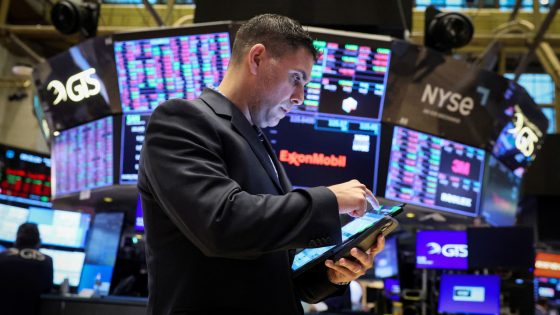The ideal fix for a market that’s traveled too far, too fast, is for it so slow down and back up a bit. This, by most appearances, is the story of the past six weeks on Wall Street. The five-month, 28% sprint from the October correction low to the record high on the last trading day of the first quarter left the S & P 500 overbought, overheated and over-loved. On cue, stocks backed off as Treasury yields migrated higher on another sticky-inflation scare until a typical-looking 5%-6% pullback in stocks relieved those technical extremes. The prevailing market and macro story lines shift more quickly than the fundamental facts, and the index bounce over the past three weeks on a mix of cooler inflation indicators, evidence of less-tight labor conditions, a message of benign patience from Federal Reserve Chair Jerome Powell and a rush of earnings reports which broadly validated the full-year profit-growth outlook. Three weeks ago here , the makings of such a pendulum swing were seen potentially coming onto view, along with the suggestion that the PCE inflation reading might reflect “the prospect of another narrative shift in a less-hawkish direction now that the market has migrated to assumptions of an indomitable consumer and a higher-for-longer rate assumption.” .SPX YTD mountain S & P 500, YTD So far, so good, three weeks down and now three weeks up, taking the S & P 500 back to within 1% of its March 28 peak. The rhythms of the rebound rally have been encouraging to the bulls in at least confirming the longer-term uptrend: Market breadth has been quite strong, global indexes are higher in sync with the U.S. and some technical hurdles were cleared (the S & P’s 50-day average put up no fight last week as the index crossed above it). But the manner and makeup of this trip above 5200 for the S & P differ from the last one in important respects, and the immediate course from here rests on next week’s inflation data and its interplay with hints of consumer fatigue. Can bad news be good news for market? Bank stocks since the March 28 market peak have outperformed the benchmark by a full percentage point while the tech sector has lagged by a similar margin. But equal-weighted consumer discretionary has had it even rougher, falling 6% this quarter, with deceleration of demand and value-sensitivity a common theme in earnings commentary. This isn’t yet a loud alarm on the broad economy by any stretch, but markets surf the rate-of-change dynamics, for the most part. The Citi US Economic Surprise Index has dipped notably below zero (meaning data are on average falling short of economists’ forecasts) for the first time in 15 months. So far, this hasn’t hurt the market broadly, in large part because cooler consumer activity (at least in the pockets where it’s evident) helps with the top priority of chilling down inflation. I generally reject the “bad news is good news” notion that supposes Wall Street is often rooting for the conditions under which the Fed will ease policy. It works only under a narrow set of circumstances: when policy is already seen as a bit too tight and when any convenient wobble in the economy is not likely to spill into a genuine downturn. Longer term, the market tracks economic fortunes. Yet Citi U.S. equity strategist Scott Chronert suggests “bad news is almost good news again.” More specifically, he tracks the correlation between S & P 500 and the Citi Economic Surprise Index. “Of late, that positive correlation has notably faded. This suggests hot macro data has increasingly threatened the soft-landing narrative that may be needed to push markets higher from these elevated valuation levels.” Earnings outlook holding up Another reason the tape has held firm against more slack macro trends is the way corporate earnings, in aggregate, have again come through “better than expected, as expected,” so to speak. Beyond the three-quarters of companies exceeding consensus forecasts and overall first-quarter growth exceeding 5%, forward guidance has been just good enough to keep the full-year estimates steady. Fidelity Investments head of global macro Jurrien Timmer fashioned this look at the path of S & P 500 earnings heading into and through each calendar year, with 2024 holding up better than 2023 was last year at this time. The last time the S & P 500 was at today’s level above 5200 in late March, the 12-month forward price/earnings multiple was 21. It’s now down to 20.4 due to better reported earnings and the passage of time bringing more distant profit forecasts into the denominator. The 10-year Treasury was mostly under 4.3% in late March, while now it sits at 4.5% after a quick trip to 4.7%. More tentative evidence that equities can absorb somewhat higher yields, within reason, so long as the economy is handling them and severe Treasury volatility doesn’t erupt. It makes for a pretty benign set of market interactions at work, though of course the CPI (and PPI) inflation releases in the week ahead â and the bond market’s reaction to them – will have plenty to say bout whether things remain in gear. Was the 5% pullback enough? Fed Chair Powell clearly has a much higher bar for contemplating tighter policy than a rate cut or two later this year. And for all the criticism and mood swings around what the Fed might do and when, the fact that the Fed funds rate has been unchanged at cycle highs for an unusually long ten months now, with the economy expanding nicely and inflation at least fitfully declining, says policy is in a reasonably good spot. There are always nagging reasons to wonder about the trustworthiness of a rally, for sure. There is election-year seasonality which points to potential weakness in stocks into Memorial Day before some summer relief. While the equity rebound in recent weeks has been broad in terms of the running advance/decline tally, the leadership profile is a bit incoherent â a mix of financials, defensive groups, some industrials and a strong mean-reversion bounce in utilities that too many are trying to impose a forced “AI power demand” rationalization upon. There is also the memory of last summer, when a rally into a late-July peak registered “overdone” signals the same way the market did in late March. Then, as now, an oh-so-orderly three-week, 5% pullback ensued, followed by a rally back above the 50-day moving average, as now. Then Treasury yields resumed a sharp rise, stoking fears about the economy’s ability to withstand them, and a fuller 10% flush wasn’t complete until late October. The global economy and the Fed’s posture, not to mention inflation levels, are all in a somewhat more favorable spot today, so there’s no saying the recent history is set to repeat. Credit markets and the volatility setup imply a lack of capital-markets stress for now, too. Some argue that the reset of investor attitudes and positioning in April looks incomplete. RBC Capital head of global equity strategy Lori Calvasina last week wrote, “Over the last few weeks we’ve argued that our sentiment indicators hadn’t fallen enough to indicate that the current pullback was over, and that remains our view today,” citing retail-investor surveys and index-futures positioning. If nothing else, this might suggest the 5% market setback didn’t pull the slingshot back quite far enough to send prices on a forceful run above the old highs. Of course, it is a bull market, and in bull markets the pullbacks often run their course before getting disorderly and scaring the crowd enough to give bargain-minded investors a juicy chance to get their fill.
Source Agencies


